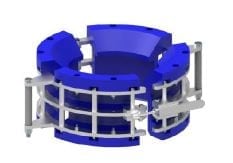Prepping Your Company for the O&G Upswing: IFS
The oil and gas industry has a tendency to boom or bust, with price driven by a number of factors—from government intervention and regulation to geographic demand variation. Chuck Rathmann, Senior Marketing Communications Evangelist, North America, at IFS, looks at how operational intelligence is helping organizations profitably manage a business reliant on long-lived assets such as drilling platforms, land-based drilling rigs, refineries and pipelines in an industry where commodity price—and profitability—can fluctuate dramatically.
In the oil and gas industry, pressure can ramp-up two-fold during peak times and companies must figure out how to maximize extraction to optimize return. Employees are a vital component for business success, and capital assets are crucial to daily operations but companies often struggle to hire skilled workers or deploy assets at short notice to ensure they are operating reliably and at maximum efficiency during heavier duty cycles.
Individual equipment components may last 25 years or more, but during slow times a rig may be idle for a year, two years or even longer. Deactivation and re-activation of equipment carry hefty price tags, and the equipment is not worth much from a resale perspective on the open market.
Finding the balance
In order to maintain their footing during these wild fluctuations in price and demand, companies in the oil and gas industry need to balance a number of interdependent factors from profitability and revenue to performance and operations. Those that can’t will struggle to remain in business for long.
Asset maintenance systems comprise the heart of operations, maintaining assets and providing a full view of operating costs. However, asset-focused systems don’t always cover the company’s other main assets—its employees—and compliance, HR, and finance are usually siloed off in separate software platforms. Establishing balance across these different parts of the business is essential and here’s where a comprehensive ERP platform that encompasses as many of these disciplines and functions as possible is key.
Outside influencers tipping the scales
Even when executives have full visibility and control over internal processes, there are always elements outside the organization that have an impact on the business and must be accounted for in management decisions. Commodity price and various economic indicators can provide insight into where price and therefore demand are headed. Oil and gas executives need the ability to pull all of these factors together from multiple enterprise software products, along with information from external data sources on a real-time basis. And this is exactly what a higher class of software, operational intelligence, can provide.
Defining operational intelligence—and it’s not BI
Decisions in the oil and gas industry are often supported by standard business intelligence tools. These tools are not up to the unique task faced by the industry. They do a great job of displaying information from published data cubes, but they rely on third party applications and manual implementation to pull information from multiple sources in an intelligent way. They will not compare directly to goals and business processes. And while they may generate an attractive visual representation of individual metrics, they are not designed to act on that information by pushing down or even automating decisions.
Operational intelligence is the next step and enables decision makers to take action on the information, either manually or through automatic triggers.
Organizations that must manage based on real-time business signals from within their four walls benefit from operational intelligence because it provides clear visualization of how value flows through the organization. It aligns metrics from numerous enterprise or point source systems and provides a way to take immediate action directly in those operational systems—enabling a much more rapid response to emerging information.
But for organizations impacted substantially by external factors, operational intelligence can provide advance notice of potential business impacts before business signals would manifest themselves looking simply at internal metrics. Operational intelligence will also provide a way to act on this information.
Regulations hard to define; operational intelligence makes them easy to identify.
The price of oil is not the only external variable operational intelligence software can track. Price shocks and other forms of operational risk can also be associated with compliance. Regulation of fracking, traditional land-based drilling, and offshore operations can change on a national level, but in a country like the United States, national regulations typically include lengthy periods of notice that act as a cushion for business impacts.
Given the impacts of fracking operations on municipal transport systems and water resources, though, we are seeing more county governments passing local ordinances that could affect operations or the ability to exercise lease options for given sites. These regulations could impact site viability in the case of a ban or moratorium or increase cost through the imposition of impact feels or mandates for water treatment reclamation. State governments are also re-examining such things as minimum royalty statutes which again could drive the cost of developing or continuing operation at a given site or group of sites affected by advancing regulation.
Offshore drilling is also affected by regulation, but even as regulations designed to protect health, safety and the environment (HSE) are rolled back, the underlying HSE concerns must be addressed to prevent civil or even criminal liability. As rigs move from the United States to international waters, different regulations apply, and this can impact not only safety and design of the rig but the amount of inventory kept on the rig in instances where a tax is levied on that inventory.
Operational intelligence software can include these compliance concerns and provide alerts if regulation begins to threaten the viability of a project or if changes to a project design begin to run afoul of current or planned regulation. It can also identify or even automate operational changes such as staffing levels or inventory levels to avoid compliance problems or unnecessary taxation given the patchwork of regulations in international waters.
An evolving industry and an evolving solution
The terminology used to refer to operational intelligence software is still developing, so researching solutions is difficult. Some vendors and analysts use the term “business operating system”; others lump operational intelligence in with corporate performance management solutions; and then there are tools for strategy management, business modeling, business process outsourcing, BI, and action management.
Operational intelligence includes elements of all of these encompassed in a real-time operational intelligence system. Without this you will always face a delay in action and decisions that will leave you exposed to needless enterprise risk.
Today, many middle-market to large companies in the oil and gas industry still rely on spreadsheets for decision support. That can result in lag times of a month or more, and a lot can happen in that time that you will not be able to react to. Operational intelligence will tell you what you need to know in real-time, give you suggestions for decision support and help you operationalize those decisions in the enterprise.
Chuck Rathman
OEM Best Practices
For 2018 Growth
by Vivek Joshi
After years of focusing on supply chain and operational initiatives, OEMs are now turning their sights to aftermarket growth. In fact, a recent TSC survey shows that for 46 percent of service leaders, service revenue will be the top initiative for 2018. This shift is a welcome change as tending to existing customers’ needs is critical for a healthy growth strategy for any company. It is also not a surprise since (a) service and aftermarket revenue is much more profitable than the sale of original equipment and (b) it should be way easier to drive cross-sell and up-sell rather than find new customers in such a competitive market.
What’s even more heartening is that approximately 31 percent of the survey respondents also indicated that Installed Base Management is a top initiative for their companies. Now this may sound obvious, but without a solid understanding of customers and their behavior and needs, revenue generation initiatives are doomed for failure. Here are the four best practices to overall help service sales, marketing, and manufacturing leaders drive double digit growth in 2018:
- Know your customers: In addition to actual coverage and renewal, OEMs must understand how customers are utilizing their products and services. Awareness of customer adoption and usage will allow for improved account management opportunities. This customer intimacy during the asset lifecycle will further create the makings of new innovative products and services in the future. It might also yield ideas for net new services that can be valuable to customers.
- Map everything: Installed base visibility is key to running successful aftermarket campaigns. Unfortunately for most manufacturers, customer data is siloed, dispersed and sometimes simply not accessible to service, sales and marketing teams. How many of you have access to the ERP? How many to the CRM? In most cases data is shared via spreadsheets which can never be updated and shared in real-time. Also, manual processes tend to drive manual errors and accidental data deletion. IT departments at large organizations and big consulting firms provide an alternative to the status quo when it comes to cleansing and organizing old data. The downside (other than time and cost) is that once the project is completed, new data rarely flows into the new architecture. After only a few months, you’re back where you started.
- Don’t wait for the phone to ring: Proactive selling is key to engage with customers, uncover business opportunities and beat your competitors. The purchasing behavior of B2B customers is changing; they expect the same level of service and engagement that they enjoy as consumers everyday. Don’t wait for the phone to ring, but also don’t make random courtesy calls.
- Call with knowledge (CWK): Speaking of courtesy calls, they simply do not work. The key to successful aftermarket campaigns is the ability to identify who to call, when, and with what proposition. Customer data and installed base visibility are the foundation of CWK.
None of this growth is possible without investing in people, process and tools and in this regard, more than 60 percent of Service Organizations are planning for budget increases to support growth. For most of these organizations the cost investment comes in the form of better account management and in sales and marketing initiatives to increase service product reach.
Data science and AI to the rescue
As pointed out in a recent Forbes article, some of the biggest challenges in the transformation from analog to digital operations on the production floor have to deal with data. Complex, legacy systems, many with proprietary applications: huge volumes of data generated by existing equipment and few resources dedicated to deriving insights from the huge volumes of data.
For many manufacturing execs, the first thing that comes to mind when thinking about digitization is IoT. In a perfect world, all machines on the factory floor are connected and are constantly streaming data into systems capable of generating insights and react to any anomaly or predetermined trigger. The reality is very different. Few machines are connected, and even fewer are streaming data. This is especially true with distribution sales and service models where the machines are being deployed and serviced by partners rather than the manufacturers themselves.
Overcoming the aftermarket growth challenge
The answer to these challenges lies at the intersection of people, processes, and tools. While the motivations have existed for a while, even if they had the right set of people in place, organizations simply did not have the tools to effectively sell to their installed base. With the advent of big data and the emergence of AI, the tools for a true system of intelligence are now beginning to take shape. We’re talking about systems of intelligence that enable manufacturers to effectively identify who their customers are, connect with them in meaningful ways, and to engage with them through the entire lifecycle of the asset. We’re talking about end-user applications that provide actionable insights to sales, marketing, and service functions and directly drive customer engagement and ultimately, top-line revenue growth. Installed base management platforms CRMs currently offer out of the box solutions for service and sales data collection and visualization, while also providing companies with the tools they need to manage inbound service request. IoT vendors have been trying for a while to solve this problem, but struggle with year long deployments, data streaming permission, as well as change management issues.
Other companies, like Entytle, are taking a different route. By applying AI and machine learning algorithms to massive amounts of historical and new customer data, their platform—Entytle Insyghts—makes sense of and enriches all ERP, warranty, CRM, and service contract information to provide enhanced visibility into the installed base and predictive business insights. This enables service, sales, and marketing professionals to proactively sell services and parts rather than waiting for the phone to ring.
The sophistication of such tools and the underlying big data and AI technologies powering them is now at a point where integrating and deploying these systems of intelligence can happen in a few weeks or months. Manufacturers and their distributors no longer have to be captive to multi-year million-dollar engagements, and can test and launch aftermarket engagement campaigns with minimum to no business disruption at all.
Vivek Joshi is the CEO and founder of Entytle, a Palo Alto-based company that helps B2B manufacturers increase customer loyalty and lifetime value. Entytle Insyghts, the first AI-driven platform for Aftermarket Engagement platform, assembles data from multiple systems, and processes that data to identify usage patterns and customer segments, deliver opportunities, and drive revenue from installed base.
Keystone Ranks Five
Key Oilfield Tools
Oilfield drilling is a complicated process employing myriad pieces of equipment to guarantee proper cleaning, safety, and extraction. While the array of oilfield equipment used can be overwhelming, especially to newcomers, this list of what we’re calling the “five most important tools” gives anyone a good starting point on what’s what in the patch. Each of the following plays a vital role in reducing environmental impact, costs, and accidents.
- Mud cleaners
The mud separated from the cuttings is used to cool down the drill bit. But prior to reaching the drill, it is crucial that the mud is as clean as it can be. Thick mud causes downtime by stopping the drill.
This oilfield tool is a mesh with small holes that stop solids from getting into the mud. This occurs right after the mud goes through a hydrocyclone. The mesh lets particles that are smaller than barite pass. Because barite can be used in drilling solutions that are thicker, the mud cleaner helps with both the current drilling and reusing resources for prospective projects.
- Stabbing Guides
Improper alignment of pipes during a drilling project can result in downtime because of threat-related downtime and pipe damage. Stabbing guides are needed to align pins to box threads, resulting in a damage-free, accurate connection. For industries that are more intense, like oil drilling, stabbing guides can also help shield against extreme temperatures, impact, and corrosion.
Pipe-handling safety is heightened because of the lowered damage risk of the tube threading, single joint elevators, or bail arms, which may cause objects to be dropped from the derrick.
- Shale shakers
The most critical part of the solids separation/control system on a rig is work of shale shakers removing the “mud” (drilling fluids) from the “cuttings” (large solids). After it has been separated, the mud is then used to cool down the drill bit. If all goes as planned, these fluids can be reused more than once. This separation prior to the cutting disposal aids in lowering environmental impact and drilling costs. Appropriate management of drilling fluids is directly related to the efficiency of the rest of the downstream controlling equipment later on.
- Degassers
Once the drilling fluids have been removed from the large solids, gas and air stuck inside the liquids must be removed. Degassers are needed to remove the hydrogen sulfide, methane, carbon dioxide, and other gases. This reduces the risk of gas explosions, thereby increasing safety at the oilfield.
Degassers come in two types: vacuum degassers and atmospheric (“poor boy”) degassers. Atmospheric degassers spread out fluids across a large surface area using a propeller, making the business of releasing trapped gases easier. Vacuum degassers separate the mud from the gases by decreasing the pressure inside the vessel.
- Sand pumps
While several pumps are used for oilfield drilling, sand pumps focus on the need to move deposits away from the drilling site. Sand pumps are most frequently placed in oil or other fluid tanks that are filled with sand. Such pumps rotate around a central axis using a grooved disk.
If any particle touches this grooved surface, it will be removed and carried through a pipe system somewhere offsite. Although called “sand pumps,” these pumps are used to move other materials as well. Aside from maintaining and cleaning tanks, sand pumps replace the use of other machinery or manual labor to move particles away from the site of the oilfield.
It is critical to acknowledge that these oilfield drilling tools aren’t mutually exclusive. Oilfield drilling demands that these tools, as well as several others, join each other in a cohesive workflow. The correct piping is needed to move solids away from the drilling site. Drilling can only continue once the clean fluids are returned to the drill.
The oilfield tools listed above are critical to a successful oil drilling project. Understanding how they work together is even more important.
This single-hinge design heavy duty stabbing guide, one of those five important tools, is by Keystone Energy Tools, of New Iberia, La.
“Stunning” Permian Production
to More Than Double by 2023
Oil production in the Permian Basin, already a major force in global supply growth, will rise nearly 3 mbd by 2023—a level of growth exceeding most recent estimates—according to a new outlook by business information provider IHS Markit. What the report describes as a “stunning” level of growth will comprise more than 60 percent of net global production growth during that timeframe.
Total oil production in the Permian will be 5.4 mbd in 2023, more than the total production of any OPEC country other than Saudi Arabia. Nearly 41,000 new wells and $308 billion in upstream spending between 2018-2023 will drive that growth.
Production of both natural gas and natural gas liquids (NGLs) in the Permian are also expected to double during this period, reaching 15 bcf/d and 1.7 mbd, respectively.
“In the past 24 months, production from just this one region—the Permian—has grown far more than any other entire country in world,” said Daniel Yergin, vice chairman, IHS Markit. “Add an additional 3 mbd by 2023—more than the total present-day production of Kuwait—and you have a level of production that exceeds the current production of every OPEC nation except for Saudi Arabia.”
The new IHS Markit Permian production outlook draws on information from the company’s proprietary Performance Evaluator database—which includes detailed information of more than one million wells globally—along with the combined analysis of IHS Markit experts covering global crude markets, North American gas, midstream and infrastructure costs, natural gas liquids, and company research.
Despite the $308 billion price tag—well above the $150 billion spent from 2012 to 2017—access to capital will not be the primary challenge for Permian production in coming years. Among other factors, the outlook expects wells to operate with positive cash flow, unlike prior years.
The outlook anticipates a market where oil prices stay around $60 per barrel or higher. In that price scenario, it is lags in necessary infrastructure, rather than the availability of upstream investment, that represents the greatest potential challenge, the report says.
“The infrastructure challenges in the Permian illustrate a fundamental mismatch between upstream oil producers and midstream players,” said Jim Burkhard, vice president and head of crude oil markets at IHS Markit. “The former are focused on fast growth while the latter require sustained high utilization of infrastructure over decades for projects to be viable.”
The IHS Markit Permian production outlook factors in the assumption that some logistical bottlenecks will occur, causing some wells to be deferred to the latter half of 2019 for instance. The Permian’s robust production growth is expected even with such constraints.
“Far from a ‘best case’ forecast, the IHS Markit outlook applies realistic scenarios and anticipates likely bottlenecks,” said Raoul LeBlanc, executive director and head of the IHS Markit Performance Evaluator. “That the outlook still expects the Permian to exceed existing (and already lofty) expectations speaks to the region’s unique and growing prominence to the world oil market. The level of growth—from 0.92 mbd in 2010 to 5.4 mbd in 2023—is truly stunning.”
Summary of Key Outlook Projections:
- Permian oil production 5.4mbd in 2023 (116 percent increase from 2017)
- Permian gas production 15 bcf/d in 2023 (114 percent increase from 2017)
- Permian NGL production 1.7 mbd in 2023 (105 percent increase from 2017)
- $308 billion in upstream spending / nearly 41,000 wells (2018-2023) in the Permian
- Total U.S crude exports increase from 1.1 mbd to 4 mbd (2017-2023)
Key Outlook Assumptions:
- WTI crude oil prices, on average, of $60/bbl or higher
- Upstream cost inflation of roughly 33 percent by 2023 relative to 2017 levels
- Net upstream cash flow 2018–23: +$47.5 billion
- A 2.5 mbd expansion of crude oil pipeline capacity
- An 8.0 Bcf/d expansion of natural gas pipeline capacity
- Additional gas processing capacity of 7 Bcf/d by 2023 to handle liquids-rich gas production
- Decelerating production growth in the early 2020s due to high capital investment requirements and an assumption of little productivity improvement
Related:
Read Jim Burkhard’s blog post about the IHS Markit Permian 2023 outlook here:www.ihsmarkit.com/research-analysis/fixing-permian-mismatch-upstream-growth-midstream-take-away-capacity.html
For more information about this production outlook or the IHS Markit Performance Evaluator, contact: Raoul LeBlanc at +1 713-568-8842 or raoul.leblanc@ihsmarkit.com
Daniel Yergin















